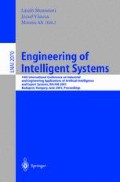Abstract
This paper concerns knowledge extraction for applications concerning the automated filling of templates from an input of semi-structured textual documents. The template filling task can be viewed as a collaboration between a number of agents, including NE-Agents that are specialised to detect occurrences of specific features in the text and TE-Agents that specialise at combining the results from multiple NE-Agents in order to create a template instance. This paper presents an automated learning approach for the generation of a TE-Agent that extracts spatial relationships between the various features of a template. It is shown that this TE-Agent can compensate for imprecise performance on the part of the NE-Agents.
Access this chapter
Tax calculation will be finalised at checkout
Purchases are for personal use only
Preview
Unable to display preview. Download preview PDF.
References
Relational Learning of Pattern-Match Rules for Information Extraction, M E Califf and R J Mooney, Proceedings ACL-97: Workshop on Natural Language Learning
LearningPinocchio, Ciravegnd F, http://ecate.itc.it:1025/cirave/LEARNING/JOBS/home.html
Information Extraction a User Guide, H Cunningham, CS-99-07, Dept. Of Comp Sci., Uni. Of Sheffield, 1999
STALKER: Learning Extraction Rules for Semistructured, Web-based Information Sources-Muslea I, Minton S, Knoblock C, AAAI’98 Workshop “AI and Information Integration”
Text Mining-Knowledge extraction from unstructured textual data, M Rajman and Besançon-6th Conf. of International Federation of Classification Societies
Information Extraction as a Basis for High-Precision Text Classification, E Riloff and W Lehnert, ACM Transactions on Information Systems vol. 12 no. 3 1994.
Learning Information Extraction Rules for Semi-Structured and Free Text, S Sonderland, Machine Learning 34, 233–272, 1999
Information Extraction from HTML: Combining XML and standard Techniques for IE from the Web, L Xiao, 2000
Author information
Authors and Affiliations
Editor information
Editors and Affiliations
Rights and permissions
Copyright information
© 2001 Springer-Verlag Berlin Heidelberg
About this paper
Cite this paper
Xiao, L., Wissmann, D., Brown, M., Jablonski, S. (2001). Where to Position the Precision in Knowledge Extraction from Text. In: Monostori, L., Váncza, J., Ali, M. (eds) Engineering of Intelligent Systems. IEA/AIE 2001. Lecture Notes in Computer Science(), vol 2070. Springer, Berlin, Heidelberg. https://doi.org/10.1007/3-540-45517-5_22
Download citation
DOI: https://doi.org/10.1007/3-540-45517-5_22
Published:
Publisher Name: Springer, Berlin, Heidelberg
Print ISBN: 978-3-540-42219-8
Online ISBN: 978-3-540-45517-2
eBook Packages: Springer Book Archive

